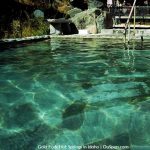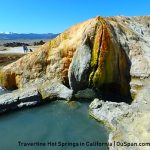
Since the time people have been on the Earth, soaking in mineral-rich hot springs is nothing new. We do not know if ancient people knew of the mineral springs healing properties, but today we are very well aware of mineral water healing benefits.
According to the US Food Drug and Administration, the water is mineral if it contains at least 250 parts per million of total dissolved solids and originates from a geologically and physically protected underground water source.
Classification Based on Mineral Content
There are numerous classifications based on the type of minerals found in the spring, but the few major ones are:
| Sulfur & Sulfate Springs
Sulfur springs contain hydrogen sulfide. This type of spring is easily identifiable by a distinctive strong smell of rotten eggs. Sulfur accounts for approximately 0.25% of the human body composition, most concentrated in keratin - structural protein, making up skin, hair, and nails. Also, it maintains proper collagen production and extremely beneficial for overall skin health, and is known as a "beauty mineral".
The gas sulfur dioxide has an antibacterial property that helps kill viruses and germs, relieving respiratory and skin diseases. Sulfur-rich water and sulfur mud are used to treat arthritis pain and rheumatism. In Europe, sulfur-rich water is prescribed to treat gynecological problems, psoriasis, dermatitis, and fungal infections.
Cautious. Hydrogen sulfide is toxic in high concentrations. Do not bathe in the unknown wild hot springs. Also, sulfur can trigger an allergic reaction in people sensitive to it.
Sulfate springs water is characterized by the presence of a sulfate anion with different cations. Sulfated water may contain combinations of magnesium sulfate, sodium sulfate, and calcium sulfate compounds. Sulfate waters improve digestion, relieve constipation symptoms, treat kidney and liver disorders. Also, such waters are prescribed as an inhalation to treat respiratory infections. Water is called sulfate if it contains over 200 ppm of sulfate ions.
| Salty or Saline Springs
Salty waters are rich in chlorides, combining with sodium, calcium, potassium, and magnesium. Sodium chloride is a major salt of many hot springs that also called saline. Typically, saline water has a neutral pH, about 7. This water is not recommended for drinking on a low-sodium diet but is considered to be beneficial for bathing. Similar to seawater, salty water is known to be a muscle relaxant, beneficial for arthritis pain, skin diseases, respiratory problems, as well as for beauty and cosmetic applications.
Well-known for thousands of years for its healing properties, the Dead Sea is one of the examples of the hypersaline lake with 34 percent salinity, containing chlorides of magnesium (51%), sodium (30%), calcium (14%), and potassium (5%).
| Bicarbonate aka Soda Springs
According to the European classification, water is called bicarbonate if it contains over 600 ppm (milligrams per liter) of bicarbonate content: sodium bicarbonate or calcium bicarbonate. Typically, bicarbonate waters bubble up because it contains carbon dioxide gas, and might have nitrogen and oxygen. When carbon dioxide content is higher than 250 ppm, carbonic acid is formed.
A few studies have shown that drinking a small amount of carbonated water stimulates appetite, improves digestion, may neutralize gastric acid secretion, increases bile acid excretion, helps to treat chronic dyspepsia, gastric ulcer, and colitis. Bicarbonate mineral water reduces "bad" LDL-cholesterol, fasting glucose in persons with diabetes, helps regulate peristalsis, improves metabolism of carbohydrates, and fat.
Note. By standards of many European countries, mineral water qualifies as medical water if it is high in chemical compositions and proven to have curative effects. Like any other medicine, consumption of medical water should be supervised by trained health staff and followed a specific protocol.
Important. Do not drink water from the hot springs if it has not been tested. It can contain a variety of harmful chemicals, pollutants, and bacteria.
Bathing in bicarbonate water improves peripheral circulation, recommended for people with hypertension, mild atherosclerosis, and nervous system imbalances.
| Radon Springs
A radioactive inert gas, radon is a carcinogen and associated with lung cancer. In European spas, a trace concentration of radon (25-30 nanocuries per liter) is used to treat rheumatism, arthritis, gout, skin diseases, diabetes, neuralgia, and gynecological problems. Radon therapy is available through bathing, inhalation, or steam.
Radon treatment is not approved in the United States.
Mineral Springs Healing Benefits
Mineral Springs Healing Benefits are related to a vast number of minerals and trace elements dissolved in the water. Among the most common are sulfur, silica, calcium, sodium, and bicarbonate.
Sulfur (Sulfate)
- Protects the body against free radical damages, prevent joint inflammation;
- Is part of every cell;
- Is abundant in keratin, which is responsible for healthy skin, hair, and nails;
- Needed to make collagen;
- Promotes retention of water that is essential for healthy cartilage, and joint fluid;
- Resists bacteria, promotes healthy skin, treats conditions such as rashes, eczema, acne, psoriasis, and dandruff;
- Promotes communication between neurons;
- Improves metabolism.
Silica
- Is part of elastin and collagen - fibers that are found in bones, cartilage, blood vessels, and skin;
- Improves conditions of skin, hair, and nails;
- Relieves arthritis pain by stimulating Chondroitin Sulfate;
- Plays an important role in mineral absorption that is essential for healthy bones and preventing osteoporosis.
Calcium
- Is important for healthy bones, essential for elderly people;
- Needed for hormone and enzyme secretions;
- Necessary for muscle and blood vessel contractions;
- Plays a role in nerve impulse transmission.
Sodium
- Maintains the balance of the body's fluid and minerals;
- Needed for nerve and muscle functions;
- Relieves arthritic pain and stimulates the lymphatic system.
Bicarbonate
- Improves circulation to the body's extremities, which is important to manage hypertension and atherosclerosis;
- Neutralizes acidity of body fluids.
Trace elements include:
Boron helps strengthen muscles and build them up further.
Magnesium plays a role in the proper functioning of the nerves and muscles, promotes relaxations, tightens the skin, and helps better calcium absorption for healthy bones.
Selenium is an antioxidant, responsible for the proper functioning of the thyroid gland.
Potassium normalizes cardiovascular rhythms, augments nerve impulse transmission, regulates the body's fluid balance, and reduces blood pressure.
Lithium helps brain function, improves memory, treats depression, enhances mood tranquility.
Arsenic is associated with tissue growth and has anti-fungal properties.
Iron plays a role in hemoglobin formation.
Related
 Balneology & Balneotherapy – Soaking for Health
Balneology & Balneotherapy – Soaking for Health
It was not long before one Tokyo doctor began to associate daily bathing in the hot springs with good health...
Imagine soaking in your bathtub, the serenity, the peace, that sensation of all your tension and stress are just melting away...
 Mineral Hot Springs – Historical Thermal Experience
Mineral Hot Springs – Historical Thermal Experience
Historians and scientists, for example, have succeeded in connecting some dots between mineral hot springs and good health...
 Hot Springs Risks and Safety Tips
Hot Springs Risks and Safety Tips
However, while mineral hot springs offer numerous health benefits, there are some things to be cautious about...
1. Sara Quattrini, Barbara Pampaloni, and Maria Luisa Brandi. Natural mineral waters: chemical characteristics and health effects. NCBI. 2017
2. Nathaniel Altman. Healing Springs: The Ultimate Guide to Taking the Waters. 2000




